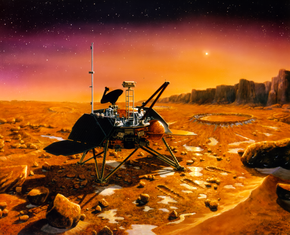Mars Polar Lander

Artist's depiction of the Mars Polar Lander on Mars
|
|
| Names | Mars Surveyor '98 |
|---|---|
| Mission type | Lander |
| Operator | NASA / JPL |
| COSPAR ID | 1999-001A |
| SATCAT no. | 25605 |
| Website | Mars Polar Lander website |
| Mission duration | 334 |
| Spacecraft properties | |
| Manufacturer | Martin Marietta |
| Launch mass | 290 kilograms (640 lb) |
| Power | 200 W solar array and NiH2 battery |
| Start of mission | |
| Launch date | 20:21:10, January 3, 1999 |
| Rocket | Delta II 7425 |
| Launch site | Cape Canaveral AFS SLC-17A |
| End of mission | |
| Disposal | failure at landing |
| Last contact | 20:00, December 3, 1999 |
| Mars lander | |
| Landing date | ~20:15 UTC ERT, December 3, 1999 |
| Landing site | Ultimi Scopuli, 76°S 195°W / 76°S 195°W (projected) |
 Mars Surveyor 98 mission logo |
|
The Mars Polar Lander, also known as the Mars Surveyor '98 Lander, was a 290-kilogram robotic spacecraft lander launched by NASA on January 3, 1999 to study the soil and climate of Planum Australe, a region near the south pole on Mars. It formed part of the Mars Surveyor '98 mission. On December 3, 1999, however, after the descent phase was expected to be complete, the lander failed to reestablish communication with Earth. A post-mortem analysis determined the most likely cause of the mishap was premature termination of the engine firing prior to the lander touching the surface, causing it to strike the planet at a high velocity.
As part of the Mars Surveyor '98 mission, a lander was sought as a way to gather climate data from the ground in conjunction with an orbiter. NASA suspected that a large quantity of frozen water may exist under a thin layer of dust at the south pole. In planning the Mars Polar Lander, the potential water content in the Martian south pole was the strongest determining factor for choosing a landing location. A CD-ROM containing the names of one million children from around the world was placed on board the spacecraft as part of the "Send Your Name to Mars" program designed to encourage interest in the space program among children.
The primary objectives of the mission were to:
The Mars Polar Lander carried two small, identical impactor probes known as "Deep Space 2 A and B". The probes were intended to strike the surface with a high velocity at approximately 73°S 210°W / 73°S 210°W, to penetrate the Martian soil, and study the subsurface composition up to a meter in depth. However, after entering the Martian atmosphere, attempts to contact the probes failed.
...
Wikipedia
